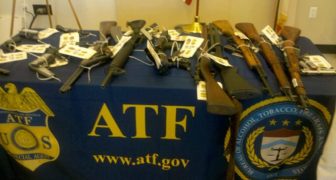This is a guest post by Andrew Betts
People like to own the same thing that the military uses. There is a perception that if it is good enough for the military, then it should far exceed the lower expectations of civilian use. This perception may not always be justified, but in the case of M855A1, it may be. The capabilities of the Army’s new “green” M855A1 62 gr EPR are truly profound. It has exceeded the performance of standard M855 in nearly every way. It both penetrates barriers and light armor better as well as produces better, more dependable tissue damage, even at low velocity.
The three part construction simultaneously allows it to punch through one layer of a barrier easily but also produce astounding tissue disruption. One can argue how well those performance characteristics fit into civilian use, of course, but there is no argument that M855A1 is at least a monumental improvement over M855 for military purposes. Will it ever be available for common folk, though? The DoD lost the suit filed against it by Liberty over the intellectual property of the design of M855A1. That means that Liberty or a licensed manufacturer could certainly manufacture it for civilian sale, at least from the perspective that they would not be violating any patents. Would the peasantry be allowed to purchase and possess the ammunition, though? It has been argued that M855A1 would be classified as armor piercing by the BATFE. In practical terms, that is not too far off. It has been able to penetrate level III+ steel body armor.
M855 cannot penetrate the plate used in the test above. Actual 7.62x51mm AP cannot even penetrate that plate, so in terms of performance, it would be fair to say that M855A1 really is armor piercing ammunition. The Army considers it to be plain “ball” ammo, though. It also does not meet the legal definition of “armor piercing” under 18 U.S.C., § 921(a)(17)(B)
“A projectile or projectile core which may be used in a handgun and which is constructed entirely (excluding the presence of traces of other substances) from one or a combination of tungsten alloys, steel, iron, brass, bronze, beryllium copper, or depleted uranium; or A full jacketed projectile larger than .22 caliber designed and intended for use in a handgun and whose jacket has a weight of more than 25 percent of the total weight of the projectile.”
While M855A1 does contain a copper core, it is not beryllium copper and therefore does not meet the definition any more than original flavor M855 did. That does not mean that the BATFE may not try to prevent its sale as well, but it does mean they would be unable to prove their case in court. Our strong response played a role in changing their mind on their attempt to consider M855 as armor piercing and they may or may not be inclined to try the same shenanigans. It does appear that it would be legal and possible for M855A1 to be made available to civilians in the US, but what is not remotely certain is whether any company would find it worthwhile.
Andrew Betts served with the Arizona National Guard for over 12 years, including a tour to Afghanistan. Visit his YouTube Channel for more great shooting information.


Speak Your Mind